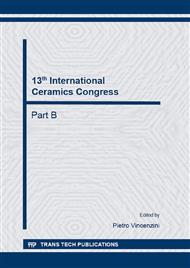p.31
p.37
p.43
p.49
p.54
p.60
p.65
p.70
p.74
Reactive Sintering of TaB2 Using Spark Plasma Sintering Method
Abstract:
Tantalum diboride was synthesized and sintered from metallic tantalum powder and amorphous boron powder in one technological process using Spark Plasma Sintering method. The precursors were: tantalum with grain size below 5μm and boron with particle size in the range of 1-2μm. Tantalum powder, before mixing with boron, was subjected to high-energy milling under argon atmosphere in order to reduce specific surface area. The process should be carried out without air, due to protection against the influence of oxygen. During reactive sintering SPS process oxidation participation should be limited because of high exothermic reactions. Morphologies of the powders before and after milling were studied using SEM. Reactive sintering processes were carried out at temperatures from 1800°C up to 2200°C at 48MPa. Sintering duration was in the range of 1-30min. Volume changes of samples and temperature increase during the synthesis were observed and determined. The result of X-Ray phase composition analysis and microstructure observations using SEM are presented. Relative density, Young's modulus, Vickers hardness and fracture toughness of the materials were determined. During the reactive sintering the material of only one phase TaB2, with high level of densification, was obtained.
Info:
Periodical:
Pages:
54-59
Citation:
Online since:
October 2014
Price:
Сopyright:
© 2014 Trans Tech Publications Ltd. All Rights Reserved
Share:
Citation:


